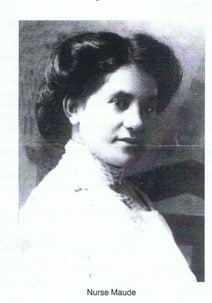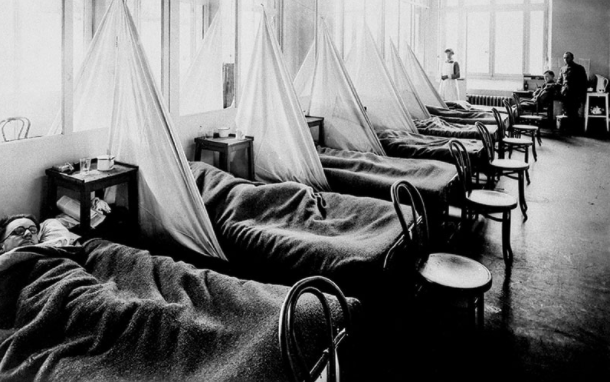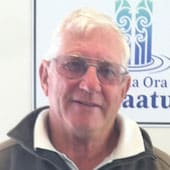In the Great War (now known as World War 1), New Zealand’s casualties were over eighteen thousand dead. At the end of 1918 nearly half that number (9,000) died in our country during the Influenza Epidemic. Throughout the world 50 million died, twice the number who died as the result of the previous conflict.
Many were buried in unmarked graves and lost in time. However I have got to know some of its victims who died nursing other people in November 1918. I was introduced to Maud Mataira when studying the origins of the Anglican Māori Mission Hospital in Whakatāne, opened by Archdeacon Tisdall at the end of 1913. Maud Mataira was the District Nurse there when Bishop Averill bought Charles Stewart’s home in Bridge Street and had it converted into a cottage hospital. Nurse Ada Jane North was appointed as the mission nurse shortly after completing her training at Napier Hospital. Her assistant Evelyn Kingi came from Rotorua, having previously trained at the Whakarewarewa Anglican Maori Mission under Sister Griffin. The Waiapu Church Gazette records Maud’s move:
“The Government Nurse has been removed from Whakatane and the Government have undertaken to subsidise our work on conditions which the Bishop has been able to accept.”
I deduced that this Government Nurse was Maud Mataira . [She was possibly given the name of Maud – sometimes spelt Maude, from Nurse Sibylia (Sibyl) Maude who established district nursing in Christchurch a decade or so earlier.] Maud was Maora Pani (her maternal grandmother’s name) Mataira from Nūhaka in Northern Hawkes Bay. Maud was born on 30th September 1884, the second child of Karepa Tukareaho and Matewai Arihi (Alice) Mataira and was baptised shortly afterwards. She came from a family of fifteen. One of her brothers was Wiremu Pere Mataira, an Anglican Priest in Waiapu. Her mother was the youngest child of the Poverty Bay trader, Thomas Halbert. In April 1865 Thomas’ schooner overturned on the Taruheru River. He and one of his companions got stuck in the mud wearing sea-boots and drowned on the incoming tide. In December that year Arihi (Alice) was born.

Maud attended Hukarere Māori Girls’ School in Napier. This I assume as the Waiapu Church Times gives a Maora Mataira as being confirmed at St. John’s Cathedral, Napier in 1907. She trained at Wanganui Hospital and completed her training in June 1911. Registration of Nurses became law in 1901 and Midwifes in 1904. The first Māori Registered Nurse was Akenehi Hei from Te Kaha. She graduated from Napier Hospital and completed her midwifery at Wellington’s St Helens Hospital in 1908. She found it hard to get work but finally won a position with the Health Department in Taranaki and then was posted to Jerusalem on the Whanganui River. There she dealt with typhoid outbreaks and improved sanitation to reduce risk to local people. In July 1910 she requested leave to nurse some of her family suffering from typhoid. Akenehi Hei died at Gisborne Hospital on 28 November 1910 from typhoid. So Maud (Maora) was one of the earliest Māori registered nurses.
In November 1906 Sister Hester Maclean began as the Assistant Inspector of Hospitals, the head nurse in reality for the country. She was responsible for introducing District Nursing in 1909, later called Public Health Nursing. In 1908 she began publishing the Nursing Journal, Kia Tiaki, this records Maud’s progress. Maud trained at Wanganui Hospital and passed her state finals in June 1911 . After an initial placement with Miss Purcell in Auckland, she was sent to Kaipara to nurse bronco pneumonia patients resulting from measles. Then she was moved to Ōhinemutu (Rotorua) to deal with “the typhoids.”

In November 1906 Sister Hester Maclean began as the Assistant Inspector of Hospitals, the head nurse in reality for the country. She was responsible for introducing District Nursing in 1909, later called Public Health Nursing. In 1908 she began publishing the Nursing Journal, Kia Tiaki, this records Maud’s progress. Maud trained at Wanganui Hospital and passed her state finals in June 1911 . After an initial placement with Miss Purcell in Auckland, she was sent to Kaipara to nurse bronco pneumonia patients resulting from measles. Then she was moved to Ōhinemutu (Rotorua) to deal with “the typhoids.”
Maud Mataira was the only District Nurse in the Bay of Plenty District in 1912. Māori were reluctant to enter hospitals so these early nurses travelled by horse, coastal steamer or whatever transport was available to sites of epidemics and set up tents or used existing buildings such as marae to care for those affected. Much of early District Nursing was setting up isolation camps, dealing with up to 20 patients alone, then sterilising equipment, taking down tents and returning them to the depot. Maud Mataira spent almost the whole of 1913 in typhoid camps, firstly in Rotorua, then Whakatāne and on Matakana Island to return to Whakatāne for a smallpox camp. This was how Maud Mataira came to be in Whakatāne briefly.
After the Mission Hospital was established in Whakatāne, the Bay of Plenty Health Department Headquarters were moved to Tauranga. Nurse North’s salary was paid by the Department and the Waiapu Diocese met the cost of the Hospital and the assistant’s income, about £20 a year. These early nurses had very basic equipment, relying on kerosene tins for boiling water on an open fire, jam jars for drinking vessels and twigs to scour bed pans.
After only a few months’ probation they were left to their own devices with an occasional volunteer. No wonder some died. Nurse Maud Mataira’s happy nature and competence were often commented upon. The 1912 health policy statement by Mr G. W. Russell, the new Minister of Public Health was reported in the New Zealand Herald:
“Much good work, Mr Russell added, was done by Maori women, and in this connection he mentioned a nurse Maud Mataira, of Rotorua, a woman whose good work was doubtless inspired by the splendid example of her friend Akenehi Hei, who died at the post of duty. Such devotion as was displayed by these women was well worthy of some public recognition.”
After the Anglican Māori Mission Hospital was set up, Maud did midwifery training at St. Helens Hospital Auckland completed in June 1914 but didn’t nurse for a period. She may have spent time with the family in Nūhaka, caring for her nephews and nieces as well as planting roses in her parents’ garden. There was talk of her being sent to Te Kaha in 1914, about 20 miles from Ōpōtiki. Early in 1917 she accepted a post at Rāwene Hospital in North Auckland. One of the children she delivered soon after beginning there was named after her – Maud Mataira Akiwa Hohepa (born 25 May 1917). The Hospital Superintendent was Dr George Smith, still remembered as a legend in the north for setting up the medical system which still serves them well today.
My sister-in-law and her husband live in Kaikohe and we went up there in February this year for a family occasion and stayed at the Rāwene Masonic Hotel. People knew the name of Dr Smith in the village and at church. There is a plaque to him in front of the hospital.

On the Saturday morning I walked from the Masonic Hotel on the water front by the ferry terminal up the hill to the Rāwene Cemetery which overlooks the Rāwene Hospital and the Hokianga Harbour. This is a fitting resting place for Maud Mataira who died nursing there. I had a moment of quiet reflection in this special place.
Maud (Maora Pani) Mataira was one of 35 nurses to die in New Zealand, nursing influenza patients during the Influenza Epidemic in 1918.
Her family were unable to attend her funeral as they lived in the Hawkes’ Bay. Her sisters recall their parents receiving an official telegram from the Whāngarei Hospital Board in 1918 saying, “Nurse Maud dead and buried.” In 1979 the family were able to locate the plot and her younger sisters had a headstone erected, overseen by a nephew who now lives nearby at Kohukohu and his brother-in-law. On Sunday 21st October 1979 it was unveiled, sixty years after her death. Unfortunately the year of death on her headstone is incorrect.
Her family published the correct details in their memorial on this day in the Poverty Bay Herald for the 22nd November 1919:
“Mataira – In loving and lasting memory of Nurse Maud Mataira, who fell a victim to the epidemic, at Rawene a year ago to-day, while in the execution of her duties.”
She was described as “a bright, pretty Maori girl and will be much missed by patients and her relatives.” Maud Mataira never married and was just 34 years old when she died.





